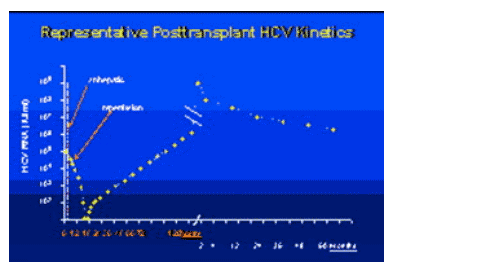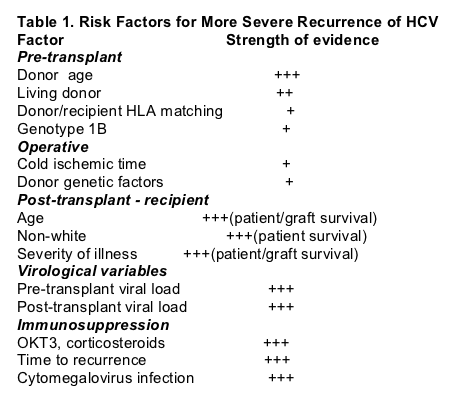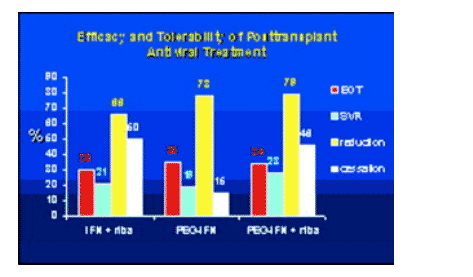| |
Recurrence of hepatitis C infection: Where are we now?
|
| |
| |
Liver Transplantation
Volume 11, Issue S2, Pages S57-S62
Published Online: 19 Oct 2005
Michael Charlton *
Department of Gastroenterology and Hepatology, Mayo Clinic and Foundation, Rochester, MN
ABSTRACT
Key Points
1 Hepatitis C-associated liver failure is the most common indication for liver transplantation, and approximately 10% of HCV-infected recipients will die or lose their allograft secondary to recurrent HCV infection.
2 Risk factors associated with histological recurrence of HCV include donor (age, fat content, ischemic time, and living donor), recipient (age and non-Caucasian race), clinical (rejection and CMV), and viral (viral load and quasispecies).
3 Treatment of recipients with histological recurrence is with pegylated IFN (± ribavirin). The role of hepatitis C immunoglobulin in the management of postransplant HCV is still evolving. (Liver Transpl 2005;11:S57-S62.)
Article Text
Liver disease secondary to hepatitis C (HCV) infection continues to be the most common indication for liver transplantation worldwide. Although the impact of HCV infection on allograft histology varies substantially, allograft failure secondary to recurrence of HCV infection is the most common cause of death and retransplantation among recipients with HCV infection.[1] In this article, we review potential strategies for the prevention of recurrent HCV infection.
Timing of Reinfection:
While the interval between liver transplantation and clinical allograft infection varies, negative-strand HCV RNA, the best indicator of HCV replication, has been detected in the first week following liver transplantation. HCV-RNA concentrations decrease by a mean decrease 0.5 log10 IU/mL in the anhepatic phase of transplantation,[2] with a calculated elimination half-life 2 hours. Based on these results, the daily production rate of HCV is estimated to be 11.6 log10-13.0 log10 viral particles in patients with chronic HCV infection. Following reperfusion, HCV RNA levels typically decrease at an exponential rate that exceeds the decrease that occurs during the anhepatic phase. While the mechanism of this early posttransplant decrease in viremia has not been determined, it seems likely that HCV binding to and/or uptake by hepatocytes are contributing factors. It is reasonable to assume that allograft infection occurs immediately following transplantation, leaving a very narrow potential window for initiation of passive immunoprophylaxis.

Figure 1. A composite of posttransplant viral kinetics are shown, incorporating results from several studies.[2][3][5] X axis time scale is non-linear, reflecting early and late kinetics. HCV levels (shown in IU/mL) fall significantly following during the anhepatic phase of liver transplantation, fall more steeply following reperfusion and continue to fall during the first 12-24 hours posttransplantation. Serum HCV RNA levels typically increase rapidly from week 2 posttransplantation and peak by the fourth postoperative month. HCV RNA levels at one 3-year posttransplantation are 10-20-fold greater than pretransplant levels.
The sum of these studies suggests that serum levels of HCV RNA typically increase rapidly from week 2 posttransplantation, peaking by the fourth postoperative month. HCV RNA levels at 1 year posttransplantation are 10-20-fold greater than pretransplant levels.[3] The timing to peak HCV RNA levels is similar to the mean incubation period following infection with HCV in non-immunocompromised hosts (approximately 8 weeks). Although the correlation of pre- and posttransplant HCV RNA levels has been inconsistent,[4] a high pretransplant viral load (>log 1 MEq/mL, a level previously associated with increased mortality and graft loss[1]) has been significantly associated with higher mean posttransplant HCV RNA levels.[5] HCV RNA at 4 months post-LT are a sensitive and specific predictor of subsequent histological activity index (HAI) and fibrosis stage.[5] In addition, high HAI scores (3) at 4 months post-LT have been associated with higher subsequent fibrosis stage.[5] These findings are consistent with reports of an association between higher HCV RNA levels and hepatocellular injury in non-immunocompromised hosts. The association of higher levels of viremia with a more rapidly progressive histological course suggests a cytopathic mechanism of HCV-induced allograft injury, perhaps related to an immunosuppression-mediated attenuation of viral clearance. Figure 1 shows a composite representation of typical post-transplant viral kinetics.
The Impact of Immunosuppression on Viremia and Recurrence:
Corticosteroid treatment for acute cellular rejection is associated with large increases in HCV RNA levels. Pulsed intravenous methylprednisolone therapy is associated with transient 4-100-fold increases in HCV RNA levels and that HCV RNA levels increase steeply (between 2 and 20 times) during episodes of acute lobular hepatitis and decrease with improved graft function.[3] HCV RNA levels do not appear to vary with choice of calcineurin inhibitor. While there are no studies in the posttransplant setting, an independent impact of cyclosporine A administration on hepatitis C viral levels was not apparent in patients with chronic HCV infection.
The impact of other immunosuppressive agents, including mycophenolate mofetil, interleukin-2 receptor antibodies, OKT3, and sirolimus, on viral kinetics is unknown.
While the relevance of studies of posttransplant HCV kinetics to timing of initiation of antiviral therapy remains to be determined, the correlation between early levels of viremia and subsequent allograft injury suggests that initiation of antiviral therapy early in the posttransplant course might be desirable. In addition, similar to posttransplant HBV infection, the window for initiation of potential passive immunity measures appears to be limited to the very early postoperative period, perhaps the anhepatic phase.
Donor and Recipient Risk Factor Modification:
Acute lobular hepatitis develops in approximately 75% of HCV recipients in the first 6 months following liver transplantation. By the fifth postoperative year, over 80% of HCV-infected liver transplant recipients will develop histological evidence of chronic allograft injury secondary to hepatitis C, with up to 30% developing cirrhosis.[5][6] A small proportion of patients (4%-7%) develop an accelerated course of liver injury (cholestatic hepatitis C) with subsequent rapid allograft failure. The course of HCV reinfection is thus greatly accelerated in liver transplant recipients when compared to that observed in patients who are immune competent. The identification and modification of factors associated with more severe recurrence of HCV infection is likely to be a component of any strategy aimed at improving outcomes.
While the basis for the observed variability in severity of recurrence of HCV infection is poorly understood, a number of potentially modifiable risk factors have been identified. Table 1 summarizes.

Viral Factors:
Viral factors that may influence disease severity include HCV genotype and quasispecies. To date, the reported impact of HCV genotype on posttransplant outcomes has been too inconsistent to influence clinical decision making. Posttransplant tracking of HCV quasispecies emergence has, in small studies, suggested a strong correlation between genetic diversification in the viral envelope region and asymptomatic or mild disease patterns. In contrast, mutations in the HVR1 area have been associated with a low likelihood of viral clearance, the development of acute HCV, lack of response to antiviral therapy, and a higher likelihood of developing hepatocellular cancer. On balance, viral factors lack sufficient sensitivity and specificity to be used in determining eligibility of patients for liver transplantation or identifying candidates for preemptive antiviral therapy.
Recipient Factors:
Several recipient variables have also been associated with poor, more severe recurrence. These include recipient age and recipient race, particularly non-Caucasian (African American, Asian).[1][6]
Donor Factors:
Donor factors associated with negative outcome in HCV-infected liver transplant recipients include 1) donor age, 2) donor fat content, 3) ischemic time, and 4) utilization of living donors. These are, potentially, modifiable. There have been three articles have highlighting an association of advancing donor age with more rapid histological progression of HCV recurrence.[7] Donor age of 50 years seems to be consistently associated with more rapid progression of fibrosis and allograft failure.
The reported impact of living donor transplantation on recurrence of HCV has been highly variable, precluding a recommendation for or against the use of living donors for recipients with HCV infection.
Clinical Factors:
A number of potentially modifiable posttransplant factors have also been associated with increased severity of HCV recurrence and poorer patient and graft survival. The impact of immunosuppression on levels of viremia has already been discussed. A strong correlation between rejection episodes that were treated with bolus corticosteroids and increased severity of histological recurrence of HCV has been well documented. The relationship between treated rejection and attenuated patient survival among HCV recipients was reported by the NIDDK Liver Transplant Database.[8] Compared to patients not treated for rejection, those treated for acute cellular rejection were independently associated with increased mortality (relative risk = 2.9; P < 0.03). While the basis of such increased mortality risk remains unclear, the two most common causes of death among HCV recipients were non-HCV infections and allograft failure secondary to HCV recurrence.
The independent effect of T-lymphocyte depleting agents, such as OKT3 and ATG, upon severity of recurrence has been difficult to determine due to the inherent overlap between antilymphocyte treatment, rejection, and cumulative steroid exposure. Regardless of the mechanism, being treated with T-cell depleting agents is a significant risk factor for both more rapid development and severity of histological recurrence of hepatitis C, associated with a 5-fold increase risk of mortality and/or graft loss.
Finally, CMV infection has been strongly associated with increased severity of recurrence.[9] This observation suggests that targeted prophylaxis against CMV might reduce the impact of CMV infection on posttransplant outcomes in HCV-infected liver transplant recipients. Further data are clearly needed with regard to the interaction between immunosuppressive agents and clinical factors as it affects overall impact of HCV recurrence. As noted previously, the development of animal models to study these relationships will greatly facilitate future progress in this area.
Antiviral Therapy of Posttransplant HCV Infection:
There have been no well-controlled, large clinical trials to determine the optimal approach to treating recurrent HCV infection following liver transplantation. Most published studies have been small, lack controls, have short periods of follow-up, and are devoid of histological analysis. Furthermore, most of the published studies are largely incomparable due to differences in the definition of recurrent hepatitis C, timing of the administration of anti-HCV therapy relative to transplantation, the drugs and doses used and the regimens employed, and the study end points assessed (i.e., biochemical, virological, and histological end points have not all been consistently investigated). A review of the published experience with antiviral therapy in the transplant setting follows.
Pretransplant Antiviral Therapy:
The NIDDK sponsored Liver Transplant Database group observed that patients with higher pre-liver transplant HCV RNA titers experienced mortality and graft loss rates 30% more frequently than recipients with lower pretransplant HCV RNA titers,[1] a finding confirmed in a subsequent European multicenter study. In light of this finding, a pilot study of the tolerability and efficacy of pretransplant antiviral therapy was conducted.[10] Only a small number of United Network for Organ Sharing status 2b HCV-infected patients met treatment-initiation criteria and were given IFN alpha, either as monotherapy or in combination with ribavirin. Although the frequency of viral response was comparable to that reported in other cohorts of patients with cirrhosis, treatment was poorly tolerated; serious adverse events, including systemic infections, occurred commonly.[10] Similar results were obtained in a single-center study incorporating pretransplant antiviral therapy. Thus, the routine use of immediate pretransplant antiviral therapy in patients with Child's B cirrhosis is not recommended. In contrast, patients with compensated cirrhosis, e.g., Child's A cirrhosis with hepatocellular carcinoma, should be considered for antiviral therapy prior to transplantation.[11]
Posttransplantation: Pegylated IFN alfa± Ribavirin:
There have been only two randomized, placebo controlled trials (an early post-OLT prophylaxis trial and a treatment trial) to evaluate the safety and efficacy of peginterferon alfa-2a in patients who had undergone OLT.[12] The prophylaxis trial enrolled 54 patients within 3 weeks after OLT, and the treatment trial enrolled 67 patients 6 to 60 months after OLT. In each trial, patients were randomized to treatment with once weekly injections of 180 g peginterferon alfa-2a or no antiviral treatment for 48 weeks and were followed up for 24 weeks thereafter. The results of both of these studies were disappointing. While peginterferon alfa-2a treated patients had significantly lower hepatitis C virus RNA levels and more favorable changes in hepatic histological features compared with untreated controls, only two treated patients in the prophylaxis trial (8%) and three in the treatment trial (12%) achieved a sustained virological response. In the prophylaxis trial, eight patients (31%) in the peginterferon alfa-2a group and nine (32%) in the untreated group were withdrawn prematurely, whereas in the treatment trial, 10 patients (30%) in the peginterferon alfa-2a group and 6 (19%) in the untreated group were withdrawn prematurely. The incidence of acute rejection was similar in the treated and untreated groups in both the prophylaxis (12% vs. 21%; P = .5) and treatment (12% vs. 0%; P = 0.1) trials. Thus, while peginterferon alfa-2a treatment for 48 weeks is safe and acceptably tolerable, the efficacy in the early post-OLT setting is much lower than in immuncompetent patients.
Other studies utilizing pegylated IFN alfa in combination with ribavirin have reported more favorable outcomes in the treatment of histologically established recurrent HCV infection, with sustained virological responses between 25% and 36%. Conversion of EOT to SVR seems to be dependent on ribavirin dosing and tolerability. Dose reduction frequencies of ribavirin of >80% and cessation of therapy in 25%-50% are being consistently reported. While ribavirin levels are likely to be more important than doses, and are certainly the major determinant of toxicity, dose adjustments of ribavirin according to levels are impractical in the absence of standardized target range or assay. As ribavirin is primarily renally excreted and has a half-life of 300 hours, the potential for dose dependent toxicity is substantial in the posttransplant setting. Dose escalation protocols, with starting doses of 400 mg/day, increasing by 200 mg/day/month to target doses is a reasonable approach. In light of the high frequency of hemotoxicity of ribavirin and recent demonstrating of the ability of growth factor support to maintain target ribavirin dosing,[13] initiation of erythropoietin or darbepoetin for patients with Hb 12 g/dL might also be considered.
Figure 2 shows mean reported virological response rates and frequencies of dose reduction and cessation for standard interferon and ribavirin, for pegylated interferon monotherapy, and for pegylated interferon plus ribavirin. The figure represents crude means calculated from full manuscripts and presentations at scientific meetings. While the greatest efficacy appears to be with PEG-IFN + ribavirin combination therapy, toxicity is also greater with 50% of recipients requiring cessation of antiviral therapy on this regimen, over half of which is secondary to ribavirin associated anemia.
Efficacy and Tolerability of Posttransplant Antiviral Treatment
SVR: 21% IFN+RBV; 18% PegIFN; 28% PegIFN+RBV

Figure 2. Comparative mean end of treatment (EOT) and sustained virological repsonses (SVR) for standard and pegylated interferon (PEG-IFN) therapy are shown. Dose reduction and cessation of therapy frequencies are also shown. Values are means derived from the pooled results of published studies (manuscripts and presentations at the annual meeting of the American Association for the Study of Liver Diseases 2002). N refers to the total number of treated patients in all studies combined.
IFN and the Risk of Rejection in Liver Transplant Recipients:
Of the handful of studies describing the outcome of standard IFN therapy of recurrent HCV in liver transplant recipients, two have suggested that IFN treatment may increase risk of organ rejection. None of the larger more recent studies of combination therapy with IFN and ribavirin have reported an increased risk of frequency or severity of rejection. Some have reported remarkably low rates of rejection during combination therapy (e.g., 0/44 patients, 1/33 patients[14]). Data from a relatively large, randomized study of peginterferon alfa-2a (40 kDa) vs. no treatment in patients with established recurrent HCV, show no episodes of late acute cellular rejection.[12] On balance, there is no compelling evidence that IFN therapy is associated with increased frequency or severity of rejection in liver transplant recipients.
Hepatitis C Immunoglobulin:
Hepatitis B immunoglobulin has moved hepatitis B infected patients from the ranks of the untransplantable to ideal candidates for liver transplantation. The hope has long been that HCV immunoglobulin (HCIg) will similarly ameliorate the impact of recurrence of HCV infection. Anti-HCV-containing HBIg reduced HCV reinfection in HBV/HCV co-infected liver transplant recipients and conferred limited protection against de novo HCV infection. However, two randomized, multicenter, placebo controlled studies of pooled hepatitis C immunoglobulin in the prevention of post-transplant HCV infection found no benefit in terms of post-transplant clinical reinfection rate or HCV RNA levels. The availability, cost, and concerns about potential infectivity of pooled HCIg is likely to limit the impact of this therapy even if ultimately proven efficacious. A new monoclonal immunoglobulin, directed at the envelope protein E2 and developed in the Trimeric mouse model, is currently in Phase 2 trials.
Summary:
Hepatitis C-associated liver failure is the most common indication for liver transplantation and the infection recurs nearly universally following transplantation. Histological evidence of recurrence is apparent in 50% of HCV-infected recipients in the first postoperative year. Approximately 10% of HCV-infected recipients will die or lose their allograft secondary to hepatitis C-associated allograft failure in the medium term. HCV-infected recipients who undergo retransplantation experience 5-year patient and graft survival rates that are broadly similar to recipients undergoing retransplantation who are not HCV-infected. While the choice of calcineurin inhibitor and/or the use of azathioprine have not been clearly shown to affect histological recurrence of hepatitis C or the frequency of rejection in HCV-infected recipients, cumulative exposure to corticosteroids is associated with increased mortality, higher levels of HCV viremia, and more severe histological recurrence. In contrast to non-HCV-infected recipients, treatment for acute cellular rejection is associated with attenuated patient survival among recipients with hepatitis C. The development of steroid-resistant rejection is associated with a greater than 5-fold increased risk of mortality in HCV-infected liver transplant recipients. In lieu of large studies in a posttransplant population, therapy with pegylated IFN (± ribavirin) should be considered in recipients with histologically apparent recurrence of hepatitis C before total bilirubin exceeds 3 mg/dL. The role of hepatitis C immunoglobulin and new immunosuppression agents in the management of posttransplant hepatitis C infection is still evolving.
|
|
| |
| |
|
|
|